#AgileWorkflow
Explore tagged Tumblr posts
Text
Increase ROI by implementing Vabro

Implementing Vabro can indeed increase ROI (Return on Investment) in various ways:
Improved Productivity: Vabro facilitate better task management, progress tracking, and collaboration among team members. With clear visibility into tasks, deadlines, and responsibilities, teams can work more efficiently, completing projects faster and delivering value sooner, thereby increasing ROI.
Enhanced Communication: Vabro often include features such as real-time messaging, file sharing, and commenting, which streamline communication within teams. Clear and effective communication reduces misunderstandings, prevents delays, and fosters collaboration, ultimately leading to higher productivity and ROI.
Better Resource Allocation: Vabro provide insights into team capacity, workload distribution, and project timelines. With this information, project managers can allocate resources more effectively, ensuring that the right people are working on the right tasks at the right time. Optimal resource allocation minimizes idle time and maximizes productivity, ultimately increasing ROI.
Faster Time-to-Market: Vabro helps team plan and execute these iterations efficiently, allowing them to deliver new features or updates to market faster. By reducing time-to-market, businesses can gain a competitive edge, capture market opportunities sooner, and generate revenue earlier, thereby increasing ROI.
Continuous Improvement: Vabro support the principles of continuous improvement and adaptation. They provide mechanisms for collecting feedback, reviewing performance metrics, and identifying areas for enhancement. By embracing feedback and making iterative improvements to processes and products, teams can deliver greater value to customers, leading to higher satisfaction and increased ROI.
Risk Reduction: Vabro enable better risk management through early detection of issues, transparent reporting, and adaptability to changing circumstances. By identifying and addressing risks promptly, teams can minimize project delays, cost overruns, and quality issues, ultimately protecting investments and increasing ROI stability.
In summary, implementing Vabro can increase ROI by improving productivity, enhancing communication, optimizing resource allocation, accelerating time-to-market, fostering continuous improvement, reducing risks, and increasing transparency across projects.
🔗 Visit www.vabro.com to know more.
#ScrumTools#AgileSoftware#ProjectManagement#TeamCollaboration#ProductivityTools#AgileDevelopment#SprintPlanning#KanbanBoards#TaskManagement#AgileTools#AgileTeams#ScrumMaster#UserStories#BacklogManagement#AgileMethodology#TeamCommunication#ProductBacklog#DailyStandup#AgileWorkflow#ReleasePlanning
2 notes
·
View notes
Text
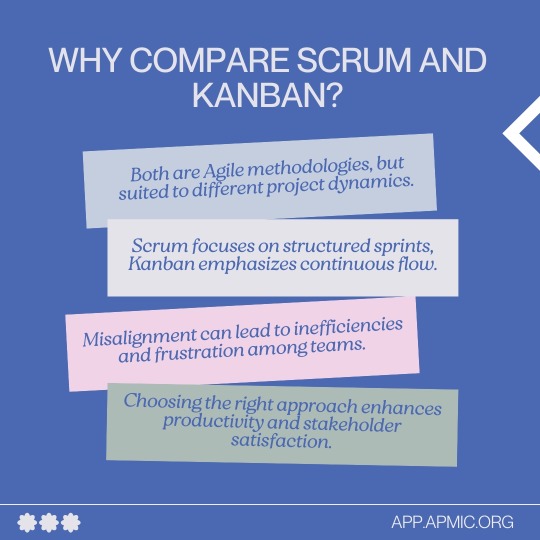
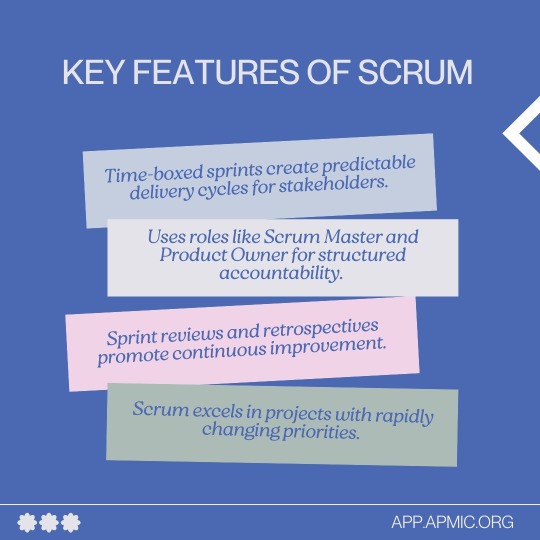
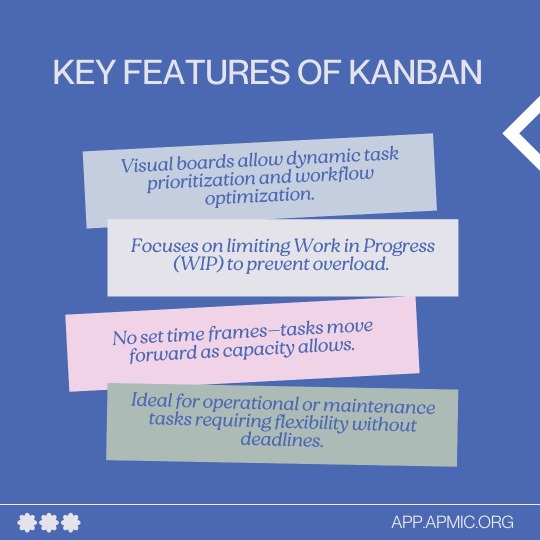
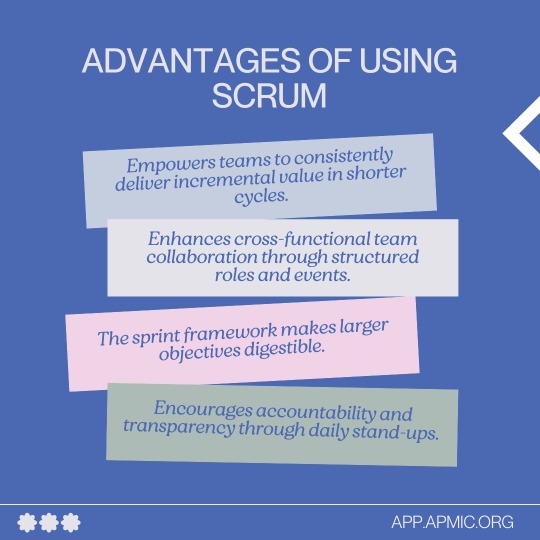
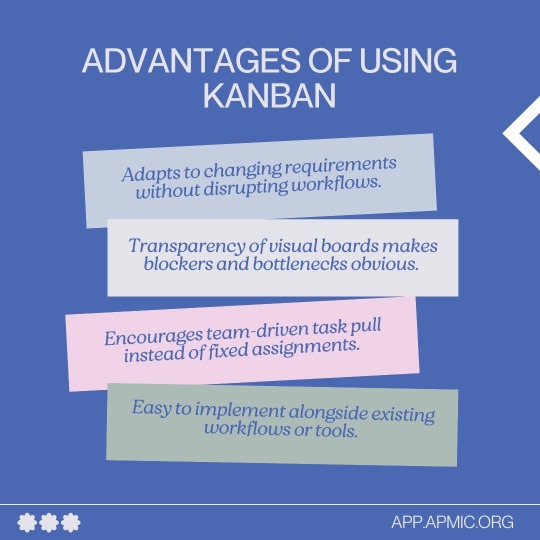

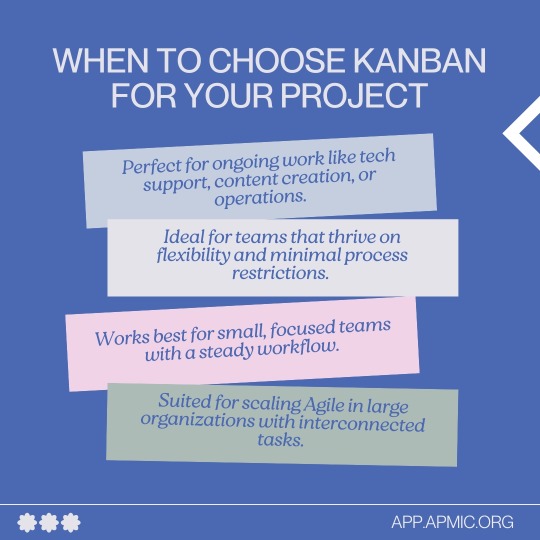



📌 Scrum vs. Kanban – Which One is Right for Your Next Project? 🚀
Both are Agile methodologies, but choosing the right one matters!
🔹 Scrum: Structured sprints, defined roles (Scrum Master, Product Owner), and predictable delivery cycles. Best for projects with evolving priorities.
🔹 Kanban: Continuous workflow, WIP limits, and no fixed time frames. Ideal for operational tasks needing flexibility.
✅ Scrum is best for: Software development, product launches, and structured teams. ✅ Kanban is best for: Ongoing work like tech support, content creation, and operations.
🔄 Hybrid Approach? Try Scrumban! Combine Kanban’s flexibility with Scrum’s sprint discipline.
📥 Follow @apmicorg for expert Agile insights!
#scrumvskanban #agileprojectmanagement #scrummaster #kanbanboard #agilemethodology #sprintplanning #leanagile #projectmanagement #scrumcoach #agileworkflow #techleadership #teamefficiency #scrumdaily #kanbansystem #projectsuccess #scrumalliance #agiletransformation #businessagility #scrumtraining #APMIC
#scrumvskanban#agileprojectmanagement#scrummaster#kanbanboard#agilemethodology#sprintplanning#leanagile#projectmanagement#scrumcoach#agileworkflow#techleadership#teamefficiency#scrumdaily#kanbansystem#projectsuccess#scrumalliance#agiletransformation#businessagility#scrumtraining#APMIC
0 notes
Text
Agile has revolutionized the way teams develop software and manage projects, offering a flexible, iterative approach that prioritizes customer collaboration, adaptability, and rapid delivery. Whether you’re new to Agile or need a refresher, this Agile cheat sheet breaks down the core concepts, principles, and tools that can help you master the framework and apply it to your projects.
#Agile#Scrum#Kanban#ProjectManagement#AgilePrinciples#Sprints#UserStories#ProductBacklog#AgileTeams#ContinuousImprovement#BurndownChart#AgileFrameworks#Collaboration#IterativeDevelopment#SprintPlanning#DailyStandup#AgileWorkflow#SoftwareDevelopment#AgileManifesto#TeamProductivity
0 notes
Text
Agile Evolution: Adapting Sprint Management for Changing Needs
In the fast-paced world of project management, the evolution of agile methodologies has become imperative to keep pace with changing needs and dynamic environments. One such evolution is the adaptation of sprint management, a key component of agile frameworks, to suit the ever-changing demands of modern projects. In this blog post, we will explore the concept of agile evolution and dive into how organizations can effectively adapt sprint management to meet their evolving needs.
Understanding Agile Evolution
Agile methodologies originated from the software development industry, emphasizing iterative development, collaboration, and flexibility. Over time, agile principles have transcended their original domain and found application in various industries, including marketing, finance, and manufacturing. This evolution reflects the need for organizations to respond quickly to market changes, customer feedback, and technological advancements.
The Role of Sprint Management
At the heart of agile methodologies lies sprint management, a framework for breaking down projects into manageable chunks called sprints or iterations. Each sprint typically lasts two to four weeks and involves planning, execution, review, and adaptation. Sprint management promotes transparency, collaboration, and continuous improvement, enabling teams to deliver value incrementally and respond to changes effectively.
Challenges in Adapting Sprint Management
While sprint management offers numerous benefits, adapting it to changing needs poses several challenges. These challenges include:
Scope Creep: Changes in project scope during sprints can disrupt timelines and priorities.
Resource Constraints: Limited resources may hinder the ability to adapt quickly to evolving requirements.
Communication Breakdowns: Inadequate communication among team members can lead to misunderstandings and delays.
Resistance to Change: Resistance from team members or stakeholders may impede the adoption of new practices.
Strategies for Adapting Sprint Management
To overcome these challenges and successfully adapt sprint management for changing needs, organizations can implement the following strategies:
Prioritize Flexibility: Embrace change as a core principle of agile methodologies. Encourage teams to remain flexible and responsive to evolving requirements.
Effective Planning: Determine precise objectives, outputs, and standards for evaluation in each sprint.Define clear objectives, deliverables, and success criteria for each sprint.
Regular Communication: Foster open and transparent communication among team members, stakeholders, and customers. Regularly review progress, solicit feedback, and address concerns promptly.
Empowerment and Accountability: Empower team members to take ownership of their work and make decisions autonomously. Establish accountability mechanisms to ensure that commitments are met.
Continuous Improvement: Embrace a culture of continuous improvement by regularly reflecting on processes, identifying areas for enhancement, and implementing changes iteratively.
Conclusion
In conclusion, agile evolution is essential for organizations seeking to thrive in today’s dynamic business landscape. By adapting sprint management for changing needs, organizations can enhance their agility, responsiveness, and ability to deliver value to customers. By prioritizing flexibility, effective planning, communication, empowerment, and continuous improvement, organizations can overcome challenges and unlock the full potential of agile methodologies.
As the pace of change continues to accelerate, embracing agile evolution becomes not just a competitive advantage, but a necessity for survival in the ever-evolving marketplace.
#artificial intelligence#projectmanagement#marketing#SprintManagement#AgileWorkflow#ProjectManagement#Scrum#TeamProductivity#AgileMethodology#ProductDevelopment#TimeManagement#TaskPrioritization#CollaborativeTeams#AgileLeadership#TaskManagement#TeamCoordination#IterativeDevelopment#ContinuousImprovement#AgileProcesses#ProjectPlanning#TeamEmpowerment#SprintPlanning
0 notes
Text
Navigating Success: How Project Tracking Software Can Transform Your Workflow
Introduction
In today's rapidly growing world, efficient workflow management is essential for success. With projects becoming increasingly complex and team collaboration spanning across geographical locations, organizations are turning to technology to streamline their processes. One such technology that has gained prominence is project tracking software. In this article, we'll explore how project tracking software can transform your workflow and propel your organization towards success.
Importance of Efficient Workflow Management
Efficient workflow management is the cornerstone of productivity and success in any organization. It ensures that tasks are completed in a timely manner, resources are utilized effectively, and project goals are achieved. However, manual methods of workflow management are often time-consuming, error-prone, and lack real-time visibility into project progress. This is where project tracking software comes into play.
Understanding Project Tracking Software
Project tracking software is a powerful tool that allows organizations to plan, track, and manage projects from start to finish. It provides a centralized platform where team members can collaborate, communicate, and coordinate their efforts in real-time. By automating repetitive tasks, providing insights into project progress, and facilitating communication, project tracking software enables organizations to streamline their workflows and improve productivity.
Benefits of Project Tracking Software
The benefits of project tracking software are manifold. Firstly, it improves organization by centralizing project-related information and documentation, making it easily accessible to team members. This streamlines communication and ensures everyone is on the same page. Additionally, project tracking software enhances collaboration by providing tools for real-time communication, file sharing, and task assignment, leading to improved teamwork and productivity.
Key Features of Project Tracking Software
Project tracking tool comes with a range of features designed to simplify project management processes. These include task management, time tracking, resource allocation, reporting and analytics, and integration with other tools and platforms. These features empower organizations to plan, execute, and monitor projects more effectively, ensuring they stay on track and deliver results on time and within budget.
How Project Tracking Software Transforms Workflows
Project tracking software transforms workflows by providing visibility into project progress, automating repetitive tasks, and facilitating collaboration among team members. By centralizing project-related information and providing real-time insights, project tracking software enables organizations to optimize their workflows, make informed decisions, and deliver projects more efficiently.
Choosing the Right Project Tracking Software
When selecting project tracking software, it's essential to consider factors such as ease of use, scalability, integration capabilities, and pricing. Organizations should choose a solution that aligns with their specific needs and requirements, and provides the features and functionality they need to succeed.
Implementation Best Practices
To maximize the benefits of project tracking software, organizations should establish clear processes and guidelines for its implementation and use. This includes providing comprehensive training to team members, setting up regular meetings to review project progress, and soliciting feedback from users to continuously improve the software's effectiveness and usability.
Common Challenges and Solutions
While project tracking software offers numerous benefits, it's not without its challenges. Common obstacles include resistance to change, lack of user adoption, data security concerns, and integration issues. However, with proper planning and support from leadership, these challenges can be overcome, and the full potential of project tracking software can be realized.
Real-Life Examples of Successful Implementation
Many organizations have successfully implemented project tracking software to streamline their workflows and achieve their project goals. From small startups to large enterprises, businesses across industries have realized significant improvements in productivity, collaboration, and project outcomes by leveraging the power of project tracking software.
Future Trends in Project Tracking
As technology continues to evolve, project tracking software will likely incorporate advanced features such as artificial intelligence, predictive analytics, and machine learning to further enhance project management capabilities. Additionally, the rise of remote work and distributed teams will drive the development of collaborative tools and platforms that enable seamless communication and coordination among team members, regardless of location.
Conclusion
In conclusion, project tracking software is a valuable asset for organizations seeking to improve workflow management, increase productivity, and drive success. By leveraging the right software solution and implementing best practices, organizations can optimize their workflows, deliver better results, and stay ahead of the competition in today's dynamic business environment.
FAQs
What industries can benefit from project tracking software?
Project tracking software is beneficial for a wide range of industries, including IT, construction, healthcare, marketing, manufacturing, and more. Any organization that manages projects can benefit from using project tracking software.
Is project tracking software suitable for small businesses?
Yes, project tracking software is suitable for businesses of all sizes. Many software providers offer scalable solutions that can accommodate the needs and budgets of small businesses.
How can project tracking software improve team collaboration
Project tracking software provides a centralized platform for team members to collaborate, communicate, and share information in real-time. Features such as task assignments, file sharing, and discussion forums facilitate collaboration and foster a cohesive team environment.
What are some common challenges in implementing project tracking software?
Common challenges in implementing project tracking software include resistance to change, lack of user adoption, data security concerns, and integration issues. However, with proper planning and support, these challenges can be overcome.
#WorkflowOptimization#ProjectManagement#ProductivityTips#TeamCollaboration#DigitalTransformation#BusinessSuccess#AgileWorkflows#EfficiencyBoost#TechInnovation#WorkplaceProductivity
0 notes
Text
CodeSync: Streamlining Collaboration with Version Control Systems
Version Control Systems (VCS) have become indispensable tools for modern software development teams, enabling seamless collaboration, efficient code management, and reliable versioning.
Download PDF Sample Report@https://www.globalinsightservices.com/request-sample/GIS24107/?utm_source=SnehaP-Article
With CodeSync, developers can track changes, merge branches, and revert to previous versions with ease, ensuring code integrity and minimizing the risk of errors. Whether using centralized systems like SVN or distributed systems like Git, VCS empowers teams to work concurrently on projects, facilitating faster iteration cycles and smoother deployment processes. By centralizing code repositories and providing granular access controls, CodeSync enhances security and compliance while promoting transparency and accountability. As software development continues to evolve, VCS remains a cornerstone of agile, collaborative workflows, driving innovation and productivity in teams of all sizes. #VersionControlSystems #VCS #CodeManagement #Collaboration #SoftwareDevelopment #Git #SVN #AgileDevelopment #CodeSync #CodeVersioning #CodeIntegrity #DeveloperTools #ContinuousIntegration #CodeSecurity #AgileWorkflow #DevOps
0 notes
Text
Atlassian Jira is a Key Tool in the Atlassian Agile Workflow
Atlassian Jira is a project management and collaboration tool for teams. It is used by more than 65,000 companies and agile development teams worldwide. It provides the capabilities necessary to manage the entire workflow, from distributing tasks to tracking and evaluating specific projects. It was specifically designed for agile teams and can support Kanban and Scrum methods. It also offers a dashboard that provides a global view of project status and specific issues.

The Atlassian Jira bug tracking system is another key tool in Atlassian's agile workflow. This application is a popular choice among Agile teams because it makes it easy to track issues related to various parts of a project. It also helps with issues that may prevent the team from completing a task, such as incomplete user stories. It can even help the team avoid production stoppages during a Sprint.
Atlassian Marketplace offers several apps for Jira. It also has a plugin for split-workload Scrum, which splits work between discovery and delivery. It also offers an app for sharing standup reports. These reports can be linked to issues and are persistent. All of these tools have been designed to help teams improve their workflow and create an agile environment.
youtube
Jira is a project management tool that Atlassian developed to help software companies manage bugs and issues. It has evolved into a robust solution for Agile system implementation and is easy to customize. Jira allows users to assign deadlines and customize notifications.
SITES WE SUPPORT
Agile Workflow – Blogger
SOCIAL LINKS
Facebook Twitter LinkedIn
0 notes
Text
Effective project management requires meticulous planning, streamlined communication, and efficient resource management. With countless tools on the market, selecting the best ones for productivity can be daunting. This blog highlights the top project management productivity tools to help teams achieve their goals efficiently and effectively.
#ProjectManagement#ProductivityTools#Asana#Trello#Jira#ClickUp#MondayDotCom#Wrike#Basecamp#Smartsheet#MicrosoftProject#Teamwork#Notion#TaskManagement#CollaborationTools#AgileWorkflows
0 notes
Text
Improve Your Processes With a Workflow Analysis Example
One way to improve your workflow is to look at how much time it takes to complete tasks. Consider which parts of the workflow take the most time and what you can do to speed up those processes. Also, look at the interactions within your company and with customers. If you find that there are unnecessary sub-steps, you can remove them.

You can also analyze the cost of each step and how long it takes. This way, you can identify those steps that are not necessary or don't advance the goal. By identifying steps that repeat themselves, you can automate them. You can also visualize the process using branching decision trees and maps. Make sure you record the time it takes to perform each step so you can compare actual time with the estimated time.
When creating your workflow analysis, you should identify the core tasks of your business and then focus on supporting tasks. This will help you determine which tasks need to be performed first. This will also help you prioritize the tasks according to business needs. The main goal of your business is to increase efficiency and productivity. But even with an efficient workflow, there can be some performance problems.
youtube
A good workflow analysis example will help you analyze onboarding and offboarding processes. It can also be used to identify areas where improvements can be made and which tasks can be automated. This will allow you to make your processes more efficient and profitable.
SITES WE SUPPORT
Agile Workflow – Blogger
SOCIAL LINKS
Facebook Twitter LinkedIn
0 notes
Text
How to Create a Workflow Analysis Example
Before you begin a workflow analysis, it's important to determine what the goals of the analysis are. For example, you can look at the number of processes and tasks that take place at your company. Once you know this information, you can prioritize tasks, create a timeline, and eliminate inefficiencies. Here are some tips to get you started.

Identify processes that can be automated or improved. For example, you might want to automate a process that requires a manager to approve. You might find that some tasks are easier to complete or take less time than others. A workflow analysis will help you identify those areas, and you can use the results to improve the process.
After you gather information from your employees, you can start looking at your existing processes. You can look for existing standards and documentation. You can also ask specific questions about the time required for different tasks and assignments. This will help you improve outdated business measures. When your company's processes are outdated, it will create a negative user experience.
youtube
Workflow analysis templates are available online and can be used to create your own workflow analysis. Then, you can modify them as needed. A template is available for MS Word, Pages, and Google Docs.
SITES WE SUPPORT
Agile Workflow – Blogger
SOCIAL LINKS
Facebook Twitter LinkedIn
0 notes
Text
What Are the Five Steps of Workflow in Jira?
Workflow is the process of resolving issues in Jira. The workflow is composed of different steps that can be executed to move issues through different states. For example, an issue may move from an open state to a closed state depending on its status. Workflow also allows users to assign different work items to different people. It also facilitates the use of different types of reports, such as progress reports and issue reports.

The process of workflow is divided into five steps. The first step involves writing the requirements for a feature. Once this step is complete, a developer will start working on the feature. The developer will mark the task in the Progress stage. The next step is to hand the build to the tester. Finally, the tester will test the build and move it to Done. These five steps provide visibility for all project stakeholders and help the project manager keep track of the project schedule and budget.
youtube
Workflow design is essential for any project. The different components of a workflow should reflect the actual business processes of the project. This means that it should not be a theoretical process; it must be practical, involving a team of experts and using appropriate tools for the job.
SITES WE SUPPORT
Agile Workflow – Blogger
SOCIAL LINKS
Facebook Twitter LinkedIn
0 notes
Text
Implementing a Workflow Application Example
A workflow application is a program that allows you to move data between different systems and apps. It can also automate specific tasks for an individual. For example, a photographer may use a workflow application to process photos before publishing them. Another example is a project team that uses a workflow application to coordinate and share information between members. It offers clear visual cues for tasks and makes it easier for everyone to see what tasks they need to complete.

Workflow applications are often built on an architecture of services. Each service has a rate of processing and a requirement for the data that it receives. These services may be movable or unmovable, and they have different types of data processing requirements. Movable services process small working streams and can move them with low overhead.
The first step in implementing a workflow application is to identify the factors that affect your business. This includes identifying all users, departments, and stakeholders. The next step is to understand how these factors relate to each other. For example, if you're a business that sells apparel, you might have many people who work on different parts of the business. Having an accurate understanding of the workflow will help you design a workflow that streamlines your workflow.
youtube
Workflow automation can be as simple as automating the delivery of a document to a particular person. It can also be as complex as aggregating data from a user and producing an analysis for another. For example, a workflow application can aggregate data about site inspections or capital assets. This eliminates the need for humans to compile the data, which saves you time and money.
SITES WE SUPPORT
Agile Workflow – Blogger
SOCIAL LINKS
Facebook Twitter LinkedIn
1 note
·
View note